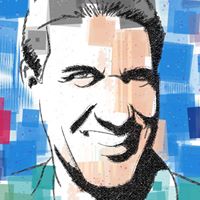 You’ve probably seen Mark Swan’s name a dozen times, but didn’t know it. As an animator for over 30 years, he’s worked for Walt Disney Studios, Universal Pictures, Warner Bros. and MGM, among others. Some of his credits include An American Tail, Land Before Time I, II, III, IV, Space Jam, A Goofy Movie, All Dogs Go To Heaven, Rock-A-Doodle, Thumbelina, A Troll In Central Park, Cats Don’t Dance, The Princess and the Pea, and for t.v., Thundarr the Barbarian, The Incredible Hulk, and The Smurfs. His work has taken him from L.A. to Dublin to Budapest and Barcelona. And the most amazing part of all of this is that he’s my big brother. I grew up watching his artwork on Saturday morning cartoons looking for the secret pictures he’d drawn for me to find. I’m thrilled to interview him about his career and his upcoming Kickstarter campaign for a comic book series all his own.
You’ve probably seen Mark Swan’s name a dozen times, but didn’t know it. As an animator for over 30 years, he’s worked for Walt Disney Studios, Universal Pictures, Warner Bros. and MGM, among others. Some of his credits include An American Tail, Land Before Time I, II, III, IV, Space Jam, A Goofy Movie, All Dogs Go To Heaven, Rock-A-Doodle, Thumbelina, A Troll In Central Park, Cats Don’t Dance, The Princess and the Pea, and for t.v., Thundarr the Barbarian, The Incredible Hulk, and The Smurfs. His work has taken him from L.A. to Dublin to Budapest and Barcelona. And the most amazing part of all of this is that he’s my big brother. I grew up watching his artwork on Saturday morning cartoons looking for the secret pictures he’d drawn for me to find. I’m thrilled to interview him about his career and his upcoming Kickstarter campaign for a comic book series all his own.
You’ve worked in animation for a long time. As such, you are quite familiar with storyboarding. Can you talk about the role storyboarding plays in creating an animated movie?
For people unfamiliar with storyboards I’ll often define it as making the comic book version of the movie. You’re drawing out the story shot by shot. It’s a lot like being the director because the storyboard artist reads the scripts and starts breaking things down into different shots and you’re making decisions like, should this be a long shot, medium shot or a close up, a pan shot, a dolly shot. You’re concerned about the composition, the acting and the transitions from shot to shot. You have various story points that you have to keep in mind, and in storyboarding, the artists think up much of the visual humor, and visual interest. 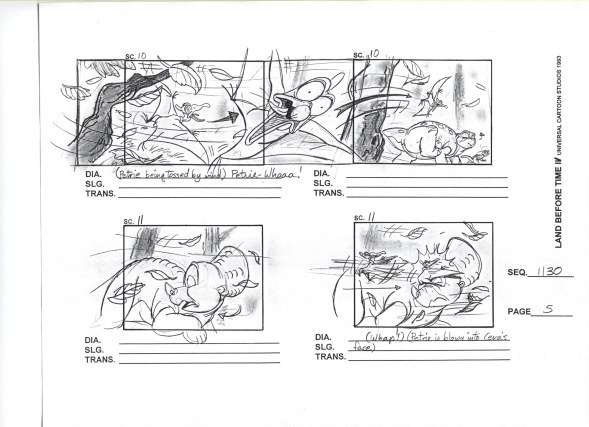
When you get a script, how do you go about creating the pictures to go along with it?
As I read a script, I get images in my mind and I’ll make a little thumbnail sketch or write a little note in the margins. I’d probably read through it a few different times and then start sketching things out. After getting the first sketches done then you have to review and edit things. In the old days we used to pin up sketches on a cork board so you could move things around, add new drawings or pull some down. You are looking for the flow of the story, the entertainment value and checking to see if you hit all the important story points for that scene.
How would you apply that to a book?
Well, it’s still story-telling in both cases. In film you are telling the story with words, pictures, sound, and music. In books you are telling the story with words and sometimes pictures. I love a well-crafted movie but there is something magical about books where readers imagine the scene in their minds and become the actors and set designers and sound effects person, etc.
The important thing is you’re trying to create interesting characters, hit all the important story points, create a good flow from scene to scene or chapter to chapter and find the entertainment value in each scene. I like it when you can develop your characters through their actions. In animated movies, dialogue heavy scenes will tend to bog down the movie so animators always try to find some kind of “business” for their characters to do while they are talking.
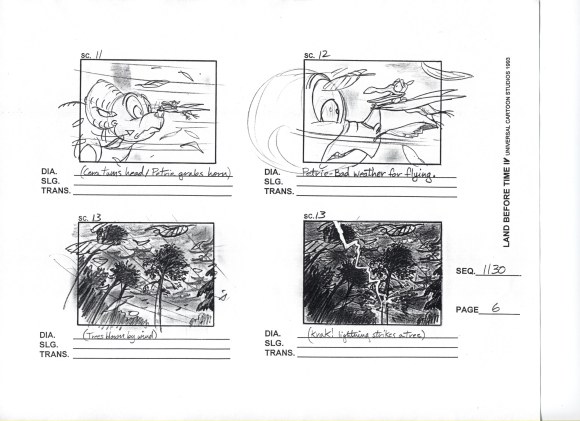
Another thing I’ve learned is the importance of editing. Every film I’ve ever worked on starts with an overabundance of ideas and then has to be stripped down. You have to make choices that start narrowing down the story. Most films have time limits and most books have page limits. It takes good editing to fit the story into the limitations of time or page count.
You’ve had a love of comic books as long as I’ve known you. In fact, you were the one who introduced me to Asterix and Obelix when I was still a kid. What is it about comic books that appeals to you?
There were some really good artists working in comics when I was younger, and their drawings were so dynamic. Jack Kirby, John Buscema, Neal Adams, Alfredo Alcala, John Romita are a few artists I remember noticing. That comic book hero with the big muscles and the action packed life was very attractive to me as a shy boy growing up in small towns.
I loved the stories of good vs. evil and the fantasy/sci-fi aspects of a lot of them. I started to lose some of my love of the superhero comics when they became darker and grittier. I know for some people, that push into more mature content appealed to them but it wasn’t my taste. So I kind of got out of collecting comics for a while.
I first discovered Asterix in the university library but they weren’t readily available to buy in the U.S. Then I lived in Ireland for a few years, and the bookstores had all the Asterix comics and Tintin and other European titles. The thing that struck me about Asterix, was even though they look like cartoons for kids, the writing is pretty sophisticated and can be enjoyed on several levels.
I think it’s interesting that graphic novels are like storyboards in a way. Would you agree?
Yes, they’re similar, there’s a few differences, but more similarities than differences. The first big difference in film is that you’re always composing everything for the same rectangular format—the screen. In a graphic novel you can have long horizontal panels, square, triangular, circular, small, all sorts of different shapes. Also, you’re designing a page to be read, so you have to order your panels in a way that the eye will follow your story in a proper progression. For us, it’s left to right and down the page.
Then in film you have cuts and transitions that you don’t have in comics. There is something called a smash cut or jump cut in film. The only way to get a similar effect in comics is to save it for the page turn and have the splash or blast on the following page to give maximum surprise and impact. 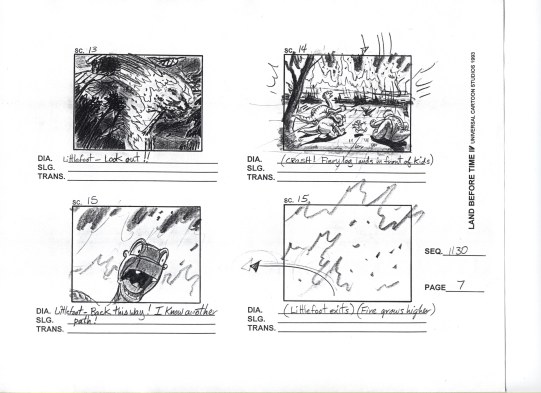
The other big difference I found in storyboards vs. comics is making room for dialogue bubbles or sound effects. I had to fight my film design instincts at first, and didn’t leave enough empty space for a dialogue bubbles. I did a lot of resizing and redrawing on my first pages because of that. Now I rough in the bubbles as part of the composition from the beginning. It makes it a lot easier.
Another difference is that because you don’t have sound in comics, you have to create it visually. Sound effects are like their own art form. There are some really awesome artists in comics that just specialize in lettering. That’s an area I’m working on improving.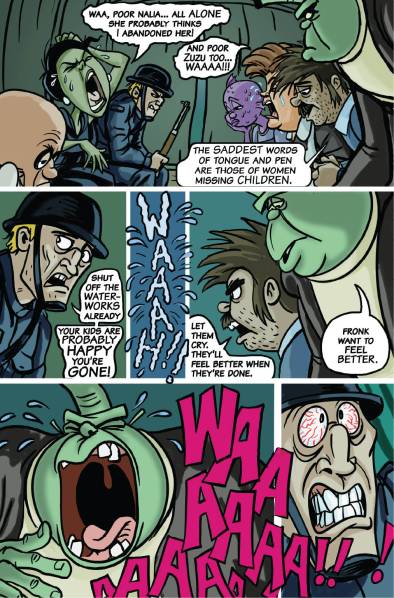
Is the storyboard aspect part of what attracted you to graphic novels?
What attracts me is storytelling with pictures. The combination of good writing and great pictures can be magical.
What are some of your favorite graphic novels or comic books?
That’s a tough question. When I was young, I loved Spiderman and Batman. I also liked Ironman, The Flash, Superman, The Fantastic Four and The Avengers. I also read things like Casper the Friendly Ghost, and Uncle Scrooge. I remember fondly a Mickey Mouse comic where he was a detective chasing after a villain called the Phantom Blot. The Asterix and Obelix series is phenomenal.
I just read a graphic novel about Spiderwoman who is fighting villains while she’s pregnant. I thought that was a really fun take on the character. There’s lots of pretty cool children’s graphic novels series, the Bone series is pretty cool. Scholastic has some fun titles as well. Leave it to Chance is another one I like. I’m just getting back into them, so there are probably some good ones I’ve missed along the way.
You’ve started a comic book idea of your own. How has doing animation helped you write in this style?
Well, both of them are visual story-telling mediums. Working in animation has taught me how to visualize and then draw what I see in my mind. You learn a visual vocabulary that you can call on just as you learn a verbal vocabulary. 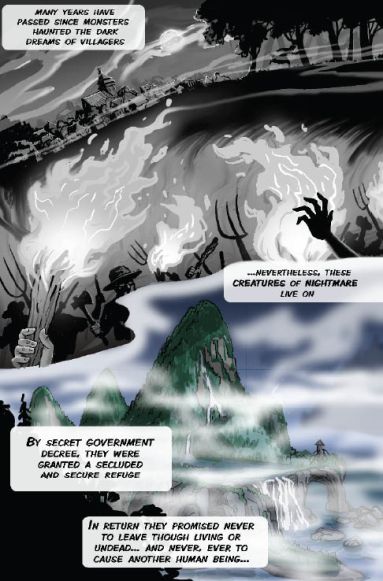
What is your comic book series about?
It’s called Monsters on the Run. I was just doodling in my sketch book and drew a young vampire girl, and then wondered what her mom might look like. Then I wondered what other monster characters I could draw that would fit into her world.
After I did the drawings, I started thinking about what stories I could tell with these characters. I knocked ideas around in my brain for a few years. There are already a lot of monster stories out there, so I wanted to find a different angle to my story.
My comic begins with the monster families living on an island in a remote lake in the Carpathian mountains. They’ve been sheltered there away from torch-bearing mobs for several years. But World War II has just ended and the Romanian government has collapsed. I created this crazy villain called Count Krumm who’s looking to take over power in Romania, so he decides he needs the best shock troops in the world, which are the monsters. 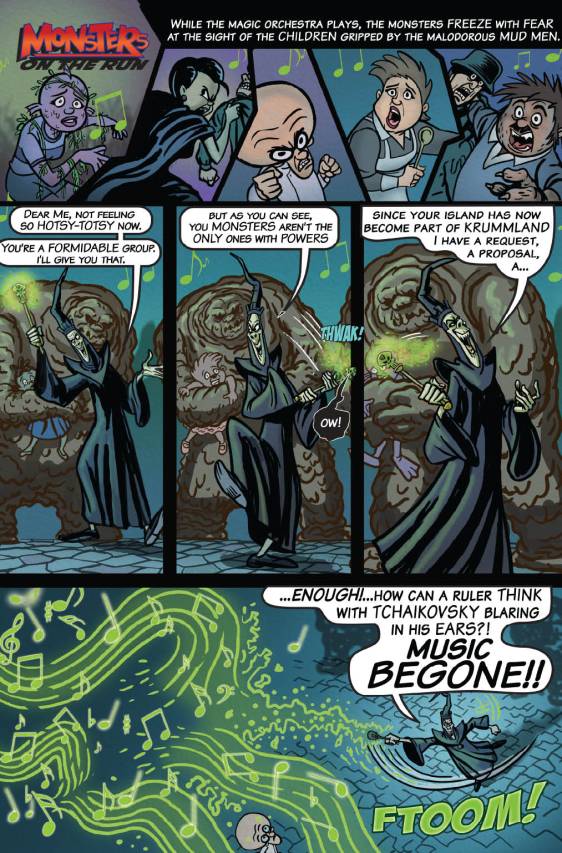
The families get separated trying to escape from Count Krumm and his soldiers. They have different adventures along the way while trying to find each other and reunite. I’m releasing it in standard comic book form, so you get about 22-24 pages per issue. I figure it’s going to take me about 50 issues give or take to finish the story the way I’m envisioning the different character arcs.
How many issues do you have completed now?
The first three are done. Issue four I have roughed out. I’ve got a general outline for the whole story and scripts written for 3 other upcoming issues. I try to write a little bit each day and draw or color a little each day before or after work. It’s a big juggling act.
I try to keep writing ahead so that I always have something to draw when I finish one. We’re planning on releasing issue #2 on May 31 in a Kickstarter campaign. I’m excited to see how successful this will be. 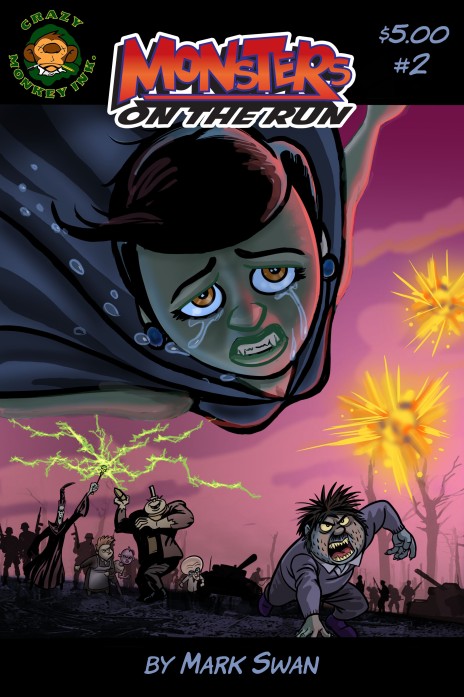
What are some of the moments in working on the films you did that helped you become a better artist?
I think the best thing about working in animation was having to produce everyday, and I was surrounded by really talented artists that I could learn from. Several of them mentored me, my supervisors when I was a beginning artist, showed me how to make my drawings stronger, like how to work with negative space and create strong silhouettes. Animation taught me how to exaggerate and how to draw strong poses.
Any fun stories to share about the movies you worked on?
I met Stephen Spielberg when I worked on American Tail. I remember when the film crew got to hear the song “Somewhere Out There.” I fell in love with it immediately. It was Spielberg’s idea to do a pop version of it with Linda Ronstadt and James Ingram. That was the first time that a song from an animated movie was reprised with a pop version over the end credits and it became a big hit. 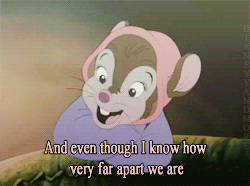
It wasn’t long after that Disney started doing that on all their animated features, to the point that it became very predictable—sing the main ballad in the movie and then create a pop version for the end. But An American Tail did it first, and Spielberg was the one who thought of it.
Most people probably think that Jurassic Park was Spielberg’s first movie about dinosaurs, but actually, it was The Land Before Time. He loved dinosaurs and he loved animation. He was the one who decided after An American Tail that he wanted to do a dinosaur movie. The premise was essentially the story of Bambi with dinosaurs.
Which was your favorite movie to work on and why?
I get asked this often and It’s probably one of the hardest questions I have to answer because I like different movies for different reasons. Some I like because they turned out well, others I enjoyed because I have great memories associated with the production and the people. It’s hard to watch one of the movies I worked on objectively because as I see different scenes come up, I have memories associated with those scenes.
I like how The Land Before Time turned out. I liked the story told in The Goofy Movie. I worked on the scene where Goofy and Max met Bigfoot. Originally, Max had a virtual-reality helmet and when Bigfoot attacked the helmet landed on his head. He ran around outside the car doing karate moves as he fought whatever he was seeing in the helmet. Eventually, it was changed to the headphones playing the BeeGees, which started Bigfoot disco-dancing. A much funnier scene I thought.
I enjoyed Space Jam because I got paid to draw all the classic Warner Brothers characters I’d grown up watching. Some of the movies I worked on when I was living in Ireland, and I had wonderful experiences in Ireland, great memories. So when I watch those movies, I think back to a lot of things that happened at that time in my life.
While working on Cat’s Don’t Dance, I got held up one night after work in the parking lot of a Bob’s Big Boy restaurant.
How can we get info about your Kickstarter campaign and where to find your comic books?
You can find it here: https://www.kickstarter.com/projects/crazymonkeyink/monsters-on-the-run-2-comic-book?ref=nav_search&result=project&term=monsters%20on%20the%20run
Thank you!

Mark illustrated a children’s book for me and I was blown away as I watched him capture and then significantly enhance characters I had created. His imagination and humor added greatly to the story. Best wishes to Mark on Monsters on the Run!
LikeLiked by 1 person
Thank you!
LikeLike
Fascinating. In my next life I’d like to be an illustrator. Mark Swan’s work is brilliant. But I take issue with his title, because my cats sure do dance.
LikeLiked by 1 person
Haha! I’ll pass that on. Thanks for the comment.
LikeLike